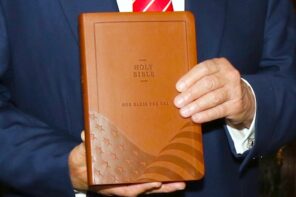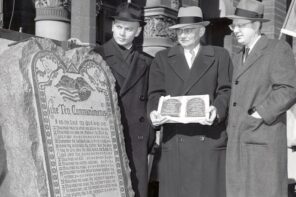Religious texts can now be searched, hyperlinked, downloaded, spliced, copied, truncated, emailed, text-messaged, recited with video accompaniment, chanted on iPod, and piped from watches into earplugs—they are available in as many digital forms as there are devices to access them.
Hopeful worshippers are even constructing their own online religious “texts” in the form of digitized prayers, video accompaniment to existing religious texts, and the recording and sharing of recitation of prayers and liturgy. But as religious texts go digital, they acquire new qualities. What are the new forms that sacred texts are taking? And what are the implications of these transformations?
For many religious folk, digital technologies are viewed mainly as tools for communication and preservation. In 2002, Pope John Paul II announced at the World Communications Day that:
While the Internet can never replace that profound experience of God which only the living, liturgical and sacramental life of the Church can offer, it can certainly provide a unique supplement and support in both preparing for the encounter with Christ in community, and sustaining the new believer in the journey of faith which then begins.
Indeed, Pope John Paul II was the first pope to use SMS (short message service, i.e. “texting”) technology to send out a “daily papal message” to believers. Pope John Paul also oversaw the creation in 1995 of the Vatican’s Web site, complete with searchable encyclicals proposing, in 1999, that the sixth-century scholar St. Isidore be the patron saint of computers and the internet.
After succeeding John Paul II, Pope Benedict XVI arranged for SMS messages to be sent to the cell phones of youth attending World Youth Day, a practice that has since become standard. This year Pope Benedict text-messaged a reminder about evangelism to all subscribers to the SMS service: “The Holy Spirit gave the Apostles and gives u the power boldly 2 proclaim that Christ is risen!—BXVI.” Recently Bishop Anthony Fisher announced the development of an associated online site for Catholic youth called Xt3.com, which Fisher describes as similar to Facebook. The spokesperson for the Vatican on these new developments, Cardinal Pell, has a page on Xt3.com, and invites Catholics to “come online and become one of my friends.”
This year’s World Youth Day also included a new feature, a “digital prayer wall,” to which participants could text-message from their cell phones and post their requests for others to pray with them in public view. GodTube, a non-denominational Christian answer to YouTube, also includes a digital prayer wall, available online at any time. The use of a digital prayer wall raises puzzling questions like: To whom are these prayers really addressed? And: Why do posters feel the need to publicly display them in a digital context? A quick read of the posted prayers on GodTube reveals that some prayers are invitations to other readers to pray “with” the poster, while others are addressed directly to God, as though He must “read” the prayer wall to learn the poster’s desires. Must God “enter” into virtual reality to read these prayers? If not, why post them at all, instead of directly and quietly praying to God, or asking a saint for intervention?
The digital prayer wall is similar to the Wailing Wall’s email service. Worshipers email a prayer to Jerusalem, where it is printed out by a courier and inserted into the wall on their behalf. If they still wish to pray “at” the wall via computer, 24-hour webcams record what is happening on location. But is it really the same thing to email a message to someone who inserts it in the wall on your behalf as to go there yourself? Is God “closer” if you visit the physical wall than if you simply view a digital image of it?
A replica of the Wailing Wall has recently been constructed in Second Life, the popular user-built online virtual “world.” The creator of the virtual Wailing Wall, “Xanadu,” explains that the digital wall, “is a peaceful spot to sit and grieve, pray, meditate, or comfort a friend. The wall accepts self-created notecards that are immediately deleted. The idea is to allow The Wailing Wall to bear away your burden.” Given the fact that both walls seem to function as a sort of “go-between” for the worshipper wanting to communicate with God, it certainly makes you wonder how the Second Life version of this activity compares to the courier service in Jerusalem in terms of what is “real,” what is “spiritual,” and what is “virtual” about prayer itself.
Other religious groups see the potential of digital technology for preservation and distribution of texts that otherwise might be lost or forgotten. The Asian Classics Input Project is the result of tens of thousands of hours put in by Tibetan monks and others supportive of their cause, all transcribing woodblock and other handwritten texts into digital formats. The “User Manual” on the ACIP Web site explains that the mission of the group is finding, organizing, “digitally preserving and disseminating rapidly disappearing Tibetan and Sanskrit manuscripts that hold the philosophical, cultural, and religious heritage of endangered cultures dating back more than 2000 years, [and to] make these books and ideas accessible to the world at large.” Now, the Web site offers thousands of texts, some removed from Chinese-controlled Tibet and available for the first time through ACIP. In their digitized form, then, the texts have a sort of durability and accessibility that they do not have in their original physical form.
As prolific as online religious texts and services are, not everyone is enthusiastic about sacred texts going digital. Indeed, some religious authorities register increasing concern about easy digital access to controlled religious texts by those who previously would not have the ability or perhaps even the desire to access them. The ease with which a Muslim can now read and search online databases of the hadith (sayings and deeds of Muhammad) has made some Muslim scholars nervous. The University of Southern California offers a searchable online hadith collection, in English, which is prefaced by a “warning” issued “especially for Muslims.” The warning explains that the early scholars of hadith were experts in the “critical science of collecting and evaluating ahadeeth,” and that students were required first to learn from the scholars how to utilize the hadith correctly. Today, however, “there is a real danger that Muslims will fall under the impression that owning a book or having a database is equivalent to being a scholar of ahadeeth. This is a great fallacy.” The archivists of the USC online database explain that it is “merely a tool, and not a substitute for learning, much less scholarship in Islam.”
Despite such warning, new technology is indeed changing the ways that Muslims access and assimilate religious rulings. In addition to using searchable digitized sources, Muslims today turn to imams online, call imams live on television shows, and even access imams via cell phones to receive new fatwas (religious rulings) for questions they may have. The recent proliferation of people claiming to have credentials to issue fatwas has created confusion and frustration among some Muslims (IOL Technology).
Who should decide, if anyone, what authoritative texts should be accessible, and to whom—when anyone with an internet hookup and a laptop can find whatever he or she desires at the click of a mouse? As argued by Dale Eickelman, Jon Anderson and the other contributors to New Media in the Muslim World (Indiana U. Press, 2003), new media access to traditional Muslim authoritative resources is forcefully challenging the most conservative modes of Islamic authority, allowing those who previously had no voice to decide for themselves what to believe and why to believe it, whether those in traditional positions of authority like it or not.
For Christians, the problem of increasing accessibility of religious texts is just as intense, but takes on a somewhat different form: namely, easy public access to texts that were rejected in the formation of the canon of the New Testament, but which offer compelling and problematic portraits of Jesus and the early Christian community. The Nag Hammadi Library, the name given to the collection of ancient Gnostic manuscripts discovered in Egypt in 1945, was first published in English by James Robinson in 1977, with a paperback version appearing in 1981.
Public awareness about the Nag Hammadi materials grew consistently in the following two decades, but exploded in 2003 with the publication of Dan Brown’s The Da Vinci Code which, more than anything, showcases Brown’s muddled if provocative incorporation of the Gnostic worldview into the novel. Fans of The Da Vinci Code don’t need to go out and purchase Robinson’s translation, they can simply read the Gnostic texts online at the Gnosis Archive. Or, if they’re interested in other early contenders for New Testament inclusion—the Gospel of Peter, for example—they can scan through the Early Christian Writings online database.
The sticky problem for Christians, as with Muslims, is authority. With individual access to a host of early Christian texts, and inspired by Brown to question the New Testament’s authority, what should people believe? Today’s Christians must decide for themselves which texts “should” have been included in the New Testament and why, and they must do so with limited information about the history and context in which these texts were composed.
The implications of such explorations are obvious: Given the competing accounts available both in the New Testament and in other ancient Christian texts, how do Christians know what Jesus really said and did? The very format of hyperlinked and searchable religious texts presents a given book of the Bible in its digital form as simply one of many files to be perused, considered, copy-pasted, and integrated into the reader’s ever-changing interpretive worldview.
For the Buddhists who follow the teachings of Thich Nhat Hanh, the problem is not the availability of religious texts online, but rather the spiritual temptations that new media poses in its ability to distract monks from meditation and study. This concern has prompted the Plum Village community in France to adopt a revision to monastic rules that had remained unchanged since the time of the first followers of the Buddha. The “Revised Pratimoksha,” warns that any monk who “keeps a television, video player, karaoke player, electronic games machine, and any other kind of equipment used for showing worldly films, listen[s] to worldly music, and play[s] electronic games” is subject to a statement of “Release and Expression of Regret.” Similarly, a monk who “goes on to the internet alone without another monk next to him as a protection against getting lost in toxic Web sites” has committed an “Expression of Regret” offense.
Some are less worried about the corrupting influence of new media at large than they are about the unsavory mixing of sacred digitized files with more plebian or even offensive digital files. For example, how should a Muslim treat an iPod once he or she has downloaded the entire Qur’an onto it? Is there a difference between downloading the Qur’an onto an iPod intended solely for worship purposes and downloading it to an iPod intended also to store a host of other (perhaps less pious) media?
What about the physical nature of video iPods as devices that must be held and viewed? One new Muslim asked recently on the Turn To Islam discussion board whether he could use an iPod as a handheld prompt while he learned to recite the prayers. In response, a poster quotes the twentieth century Saudi Arabian Muslim scholar Sheikh Muhammad b. Sâlih al-`Uthaymîn as arguing against this use of a text, as it distracts from the bodily movements required in Muslim prayer. The poster likened this fatwa’s proscriptions to the use of iPods, advising the new Muslim to avoid it during prayer.
There is also the issue of the virtual relay of religiously significant messages and the implications this may have on God’s ability to “hear” prayer wherever it is uttered, as well as the concern that digital technology might somehow dilute the sacredness of a religious message. Is something important lost in the 2005 translation of the entire Bible into SMS, when the first passage in Genesis becomes: “In da Bginnin God cre8d da heavens & da earth?” And what are we to make of the “Text Mary” service, embraced in 2005 in the Philippines, which allows worshipers to send text prayers via cell phones to then be included in the Catholic mass? Should Muslims consider a divorce legitimate if the husband, who is required to tell his wife three times that he wishes to divorce her before it is final, simply texts her or emails her instead of telling her personally, a problem that Malaysian Muslims have recently been addressing? In Malaysia, the practice was banned, but Egypt was still debating the issue in January 2008.
Michelle Boorstein of the Washington Post points out that these questions can get thornier still, when she asks:
Is it rude to watch your phone in church—if that’s where you’ve downloaded your Bible? Can text-message blessings be spiritually enriching? Is there a sense of religious community on a cellular phone?
Tony Dokoupil of Newsweek asks: “[S]hould Jesus and Madonna (the singing one) go on the same iPod?” Later, he wryly observes that “downloading the Word through the same fiber-optic cables as the latest Korn album sounds like a bad idea, given that Roman Catholics dispose of holy water through special pipes to keep it from touching sewage.” The implicit question here is about the boundaries of sacred literature in a digitized world. Should digitized sacred texts be viewed as confined to the digital file alone; or if, once a sacred text has been downloaded onto a digital device, should the entire hardware device then be considered the “vessel” for the sacred text, and treated accordingly? In other words, if you download a religious text as a file onto your iPod, is it the file alone that is sacred, the iPod itself, or something else entirely, and if so, what?
For some religious people, concerns about digital technology even spill over into the potential polluting uses to which that technology could be put, whether it actively is now or not. Concerned about the mere ability of cell phones to be used for impure activities, some Jewish cell-phone users have requested so-called “kosher” phones. The idea is to offer conservative Jews a phone that is free of “corrupting influences” of the sort that are already avoided by ultra-orthodox Jews through a ban on television and some radio. Reuters reported in February 2008 that Bezeq Israel Telecom launched a new “kosher” landline phone service, which will block calls to porn and other “improper” destinations for these conservative groups. The same sentiment appears to be troubling religious courts in the United Kingdom, where judges are hearing a case about whether or not church steeples can host mobile phone masts, since the masts might be used to relay porn.
Whether one embraces, challenges, or rejects the use of digitized sacred texts and the technology used to support them, they are here to stay. Some will see digitized texts as “the same as it ever was,” simply delivered via a new medium, and preserved for future readers. Others wish to restrict the digital multiplication of these texts, seeing accessibility as a threat to traditional religious authority. Still others feel apprehensive about the way in which sacred texts are stored, and worry that placing a sacred digital file too close to a profane one might somehow be spiritually irresponsible. And then there are those who delight in the new transformation of religious texts into digital formats, enjoying the questions raised and finding the puzzle of what makes something “sacred” enhanced immeasurably by the appearance of a new non-physical “space” in which we can invest ourselves.




